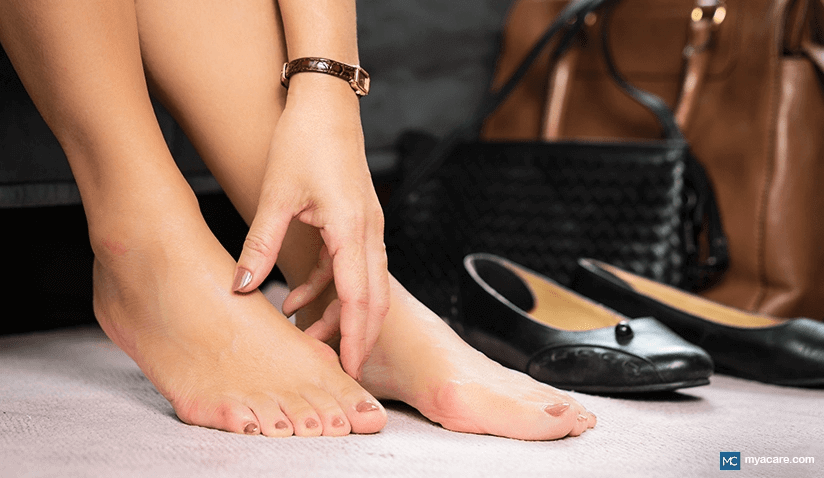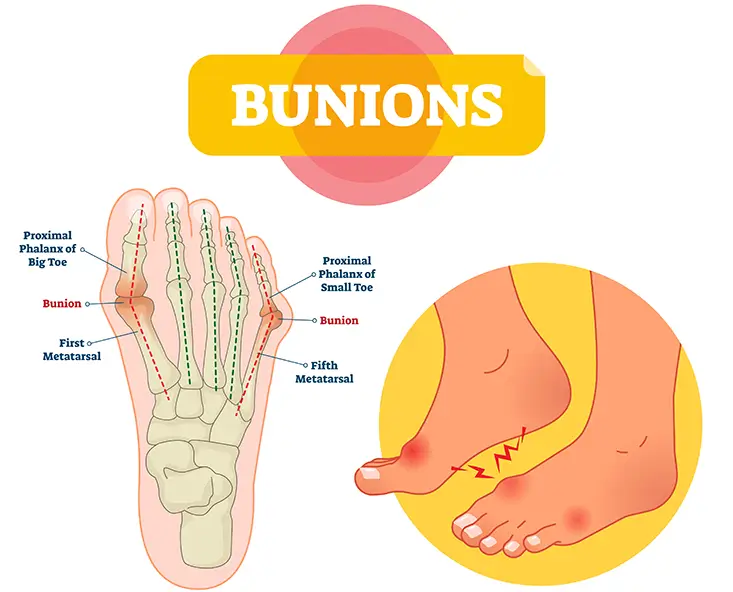Foot Bunions: Causes, Symptoms, and How to Fix Them

Everyone has heard of the sometimes painful deformity of the big toe known as bunions. According to research, 23 percent of people aged 18 to 65, and 36 percent of those older than 65 have bunions. This means that there’s a good chance you or your loved ones will experience it in your life.
The good thing? Bunions are treatable, and there are many ways to deal with them.
A doctor that deals with foot disorders such as Bunions is known as a podiatrist. Whether you prefer bunion surgery, a non-surgical bunion corrector, or rather resort to natural ways to heal bunions - we detail all your options in this article.
What are Bunions?
A bunion (also called hallux valgus) is a toe deformity that takes the shape of a bony bump on the joint at the base of your big toe. In very basic terms, it is the joint of your big toe jutting out from the sides of your feet.
Bunions are a result of the bones in the front part of the foot moving out of place. Essentially, what happens is that the tip of the big toe starts bending towards the smaller toes. This leads to the joint at the base of your big toe sticking out - which obviously leads to a certain level of deformity, discomfort, and pain.
Nevertheless, in many cases, bunions are painless. Yet, it is not wise to leave them unattended because sooner or later, a bunion may lead to the rest of your toes crowding together. Not only does this hurt you, but it may also lead to permanent deformity of the whole foot.
Symptoms of Bunions
In most cases, the following are the symptoms of hallux valgus:
- A large bump on the base of the affected toe causing toe deformity
- Redness
- Pain and soreness
- Numbness
- A burning sensation
- Swelling at the joint of the affected toe
- Increased skin thickness at the base of the affected toe
- Hardened skin under the foot
- The presence of corns or calluses
- Movement restriction within the affected toe
These symptoms may be related to another condition as well. Therefore, to make sure that you have a bunion and nothing else, you must refer to a doctor as soon as two or more of these symptoms persist. You’ll know it’s time to visit a doctor when any of the following starts to occur:
- Ongoing big toe or foot pain
- A visible bump on your big toe joint
- Decreased movement of your big toe or foot
- Difficulty finding shoes that fit properly because of a bunion
Remember - bunions are not likely to cause pain, so there’s no need to wait for tangible discomfort before you go to a doctor. You are more susceptible to occasional flare-ups, and before that happens, you should already have some medical guidance to keep things under control
What Causes Bunions?
Most commonly, bunions are a result of an inherited foot type or shape. However, there are some other causes of bunions such as:
- Foot stress or injuries
- Deformities present at birth
- Overpronation (When your foot is excessively turned inward for an extended time)
- Joint hypermobility (If your joints have an abnormal range of motion)
- Types of arthritis (Joint inflammation)
In addition, certain risk factors worsen bunions over time and are likely to cause regular flare-ups:
- Wearing high heels
- Wearing ill-fitting shoes
- Wearing shoes with pointy toes
- Standing for a long period of time

How to Ease Bunion Pain?
Bunions are painless most of the time. However, they can cause flare-ups and cause pain if they are aggravated by the aforementioned risk factors. So, you might want to get a few tips on how to deal with bunion pain ready at hand.
The following tips will help you deal with bunion pain during flare-ups:
- Try wearing wide shoes with soft sole and low heels
- Treat your bunions with ice packs regularly
- Give bunion pads a try
- Take off-the-counter painkillers for temporary relief
During a flare-up, the tips laid out above will surely help. However, these pointers will not help you get rid of your bunions completely. Neither will they stop them from getting worse. The good news? There are ways that you can do that as well.
How to Get Rid of Bunions?
There are several surgical methods to treat bunions. However, if you rather avoid surgery and think it to be a little too invasive for your condition, you can opt for non-surgical and natural bunion removal remedies as well.
Non-surgical Bunion Treatment
If you’re looking for a natural way to shrink bunions without surgery, you might want to dig into the following options:
- Have your physician pad or tape your foot into a normal position
- Take anti-inflammatory pain relievers (like aspirin or ibuprofen)
- Get custom orthotics for bunion relief (bunion correctors)
- Get bunion pads like silicone gel sleeves and moleskin
- Try lidocaine patches
- Try steroid or cortisone injections (infrequently!)
- Try regenerative medicine or topical compound creams
- Incorporate exercise and stretching into your daily routine
As you can see, none of these methods are too invasive and they can shrink bunions naturally. However, you must also keep in mind that none of these methods is going to be as effective or prompt as surgery.
Bunion Surgery
If you are considering bunion surgery, you should know that there are different procedures available. Your surgeon will help you choose the best option according to your specific condition.
Below, we have listed the kinds of bunion surgery available. Try to look into all of these to figure out which one suits you the best. Then, your doctor can give you further guidance, and together you can finalize the right procedure for your condition. Here is the list of hallux valgus surgeries:
- Osteotomy or Exostectomy (removal of excess bone)
- Arthrodesis (joint stabilization using plates or screws)
- Resection arthroplasty (reconstructive joint surgery)
- Repair of the tendons and ligaments (if damaged)
Each of these procedures is intricate and technical in its own right, so make sure you opt for the best medical help to undergo your surgery. Your surgeon might perform one or a combination of these techniques to treat your bunions.
In general, hallux valgus surgery is followed up with a 6-month long recovery period, during which you will have to closely monitor your foot and regularly visit your surgeon.
Should I Have My Bunions Surgically Removed?
As we have reiterated throughout this article, bunions cause you pain only occasionally, and that too only in some cases. However, if you feel like having bunions is interfering with your quality of life, you must look into getting hallux valgus surgery.
To give you an overview, surgery is the best option for you if:
- Your bunion is regularly causing you a lot of pain.
- The pain is negatively impacting your daily activities.
- You are unable to wear shoes that are required for your job.
- Custom orthotics (shoe inserts) have not helped.
- Over-the-counter anti-inflammatories (ibuprofen, naproxen) have not given you sufficient relief.
Like every other surgery in the world, bunion surgery will also be a commitment. This means that you will have to spend some time, money, and effort on surgery and recovery. So, before choosing surgery, make sure you discuss it thoroughly with your treating physician.
What Happens if a Bunion is Left Untreated?
If you leave your bunions untreated, they will continue to grow in size. Needless to say, this will result in more pain and discomfort. Moreover, it can permanently change the appearance of your foot and make it hard for you to find the right kind of footwear.
Whether you opt for temporary, non-surgical bunion correctors/controllers, or you go for surgery - getting your bunion treated is what matters.
The long-term effects of bunions also include:
- Loss of toe mobility
- Increased risk of joint infections
- Bursitis (inflammation of tissue cushions around your joint)
- Hammertoe deformity
- Metatarsalgia (foot pain)
- Permanent foot deformities
In short, bunions may not be harmful initially, but if you fail to treat them properly, they might end up causing long-lasting damage.
FAQs
What is the medical term for bunions?
The medical term for bunions is hallux valgus.
What causes bunions?
Bunions are usually a result of genetic abnormalities such as flat feet, excessive ligamentous flexibility, abnormal bone structure, and certain neurological conditions. These cause the internal bone structure of the toe to get out of balance.
How are bunions diagnosed?
The doctor will take a look at your medical history, run an examination, and investigate (usually through X-rays) to establish a diagnosis of hallux valgus.
Will a bunion go away on its own?
No, a bunion will not go away on its own. In fact, it only gets worse with time. To shrink bunions or get rid of them, you will need appropriate medical or surgical therapy.
Does going barefoot help bunions?
Although this is an attractive prospect, going barefoot is unlikely to help with bunions and can in fact cause even more problems. Therefore, it should be avoided.
What are the treatment options for bunions?
Mild cases with minimal symptoms can be treated by shoe modifications. For moderate cases, you may have to take pain relief medication and the help of additional orthotics. If those don’t work for you and your bunion situation progresses into a serious case, then you might want to go for a surgical procedure.
To search for the best podiatric healthcare providers worldwide, please use the Mya Care search engine.
Dr. Mersad is a medical doctor, author, and editor based in Germany. He has managed to publish several research papers early in his career. He is passionate about spreading medical knowledge. Thus, he spends a big portion of his time writing educational articles for everyone to learn.
Sources:
Featured Blogs



